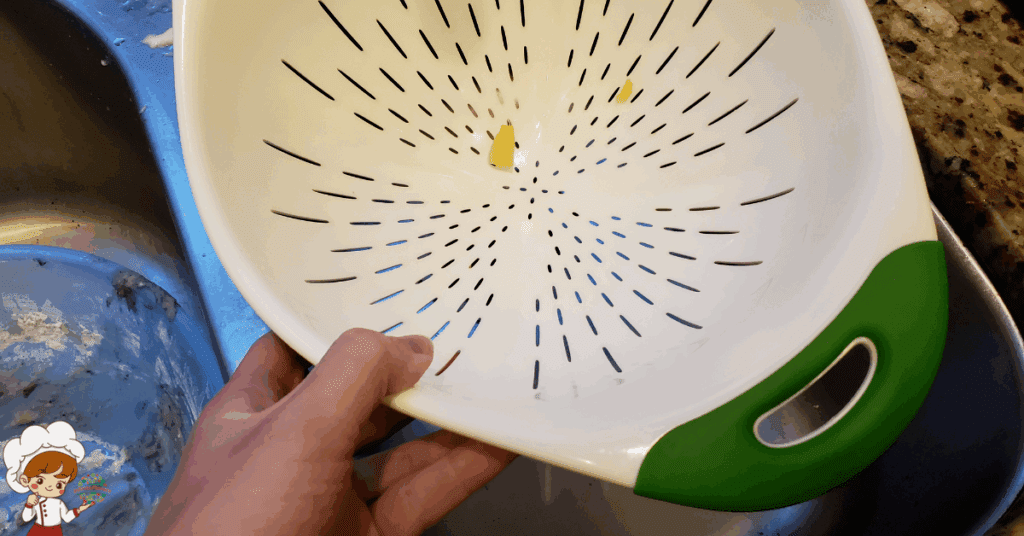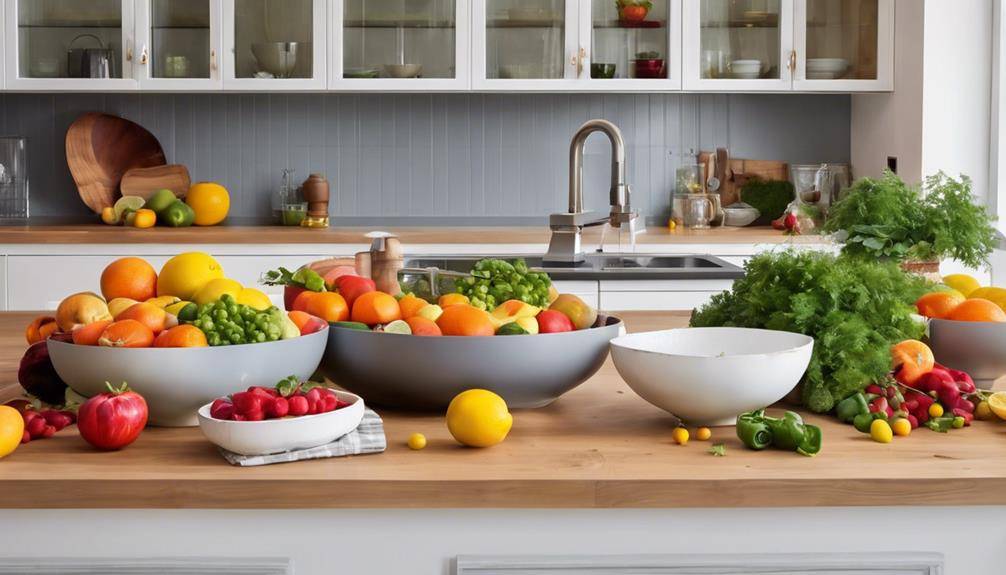Lightweight Colanders For Easy Handling

Lightweight Colanders For Easy Handling; Lightweight colanders are perfect for making your kitchen tasks easier and more enjoyable. They reduce strain on your wrists and arms while allowing effortless maneuverability between your sink and stove. Look for options made from durable plastic or flexible silicone, as these materials offer excellent portability. Ergonomic handles are a game-changer, giving you a comfortable grip for easy pouring. Plus, lightweight designs let you lift and drain with ease. Whether rinsing veggies or draining pasta, these colanders make cooking a breeze. Keep going to discover even more tips on choosing the right colander for your kitchen needs!
Benefits of Lightweight Colanders
Lightweight colanders are a game-changer in the kitchen, making meal prep easier than ever. Their design innovation focuses on functionality without sacrificing convenience. You’ll appreciate how effortlessly you can handle these colanders, even when they’re full of pasta or vegetables. Unlike traditional options, lightweight colanders reduce the strain on your wrists and arms, allowing you to drain and rinse your ingredients quickly.
When it comes to user preferences, lightweight colanders stand out. Many home cooks prefer them for their portability and ease of use. You won’t have to worry about lugging a heavy colander around; instead, you can easily move it from the sink to the stove or dining table. This flexibility makes them ideal for various tasks, whether you’re washing fruits, draining canned beans, or rinsing grains.
Moreover, lightweight colanders often come in vibrant colors and modern designs that can brighten up your kitchen space. You’re likely to find options that fit your personal style, making cooking not just functional but enjoyable.
These colanders also tend to be made from durable materials that resist staining and odors, ensuring they’ll last through countless meal preps. Overall, the benefits of lightweight colanders are clear: they combine ease of use, design innovation, and a focus on user preferences, transforming your cooking experience. You’ll find that once you switch to a lightweight colander, you won’t want to go back.
Key Features to Consider
When choosing a colander, it’s vital to take into account several key features that enhance its usability and functionality. First off, consider the material. Lightweight colanders made from durable plastic or stainless steel are great choices, as they combine ease of handling with strength. Look for design innovations like ergonomic handles that provide a comfortable grip, allowing you to pour out liquids without straining your wrists.
Next, think about the size and shape. A colander that fits snugly in your sink or over pots is essential for efficient draining. You’ll also want to check the size of the holes; smaller holes are better for draining tiny pasta shapes, while larger holes work well for rinsing vegetables.
Color options can also play a role in your decision. A vibrant-colored colander can brighten up your kitchen and make cooking more enjoyable. Plus, if you choose a colander that matches your other kitchen tools, it can help create a cohesive look in your space.
Top Lightweight Colanders on the Market
When you’re searching for the best lightweight colanders, consider materials that offer durability without the bulk. Look for compact designs that make storage a breeze, so you can keep your kitchen organized. Plus, versatile uses in the kitchen will guarantee you get the most out of your investment.
Best Materials for Durability
Choosing the right material for your colander can greatly impact its durability and performance in the kitchen. When you’re making material comparisons, consider options like stainless steel, plastic, and silicone. Stainless steel is known for its longevity; it doesn’t rust or stain and can withstand high temperatures during cooking and cleaning. If you’re looking for something lightweight yet durable, high-quality plastic colanders can be a great choice. They’re often dishwasher safe and resistant to cracking, making them easy to maintain over time.
Silicone colanders are another option worth considering. They’re flexible, which makes them easy to store, and they’re typically heat-resistant. However, it’s important to verify for quality, as not all silicone products are created equal.
For durability testing, look for colanders that are reinforced at stress points and have sturdy handles. This will guarantee they can handle heavy loads without warping or breaking. Ultimately, the best choice depends on your specific needs and how often you plan to use your colander. By understanding these material options, you can find a durable colander that will serve you well for years to come.
Compact Designs for Storage
For those tight on kitchen space, compact colanders offer a smart solution without compromising functionality. These cleverly designed tools help you drain pasta, rinse veggies, or wash fruits while taking up minimal room in your cabinets. You’ll appreciate their space-saving solutions, especially if you live in a small apartment or have a crowded kitchen.
When choosing a compact colander, look for collapsible or foldable models. They easily shrink down when not in use, making storage a breeze. Lightweight materials like silicone or plastic can also enhance portability, giving you travel-friendly options for camping or picnics. You won’t have to worry about extra bulk in your bags!
Some colanders come with stackable designs, allowing you to nest them within other cookware. This feature maximizes your storage efficiency, ensuring you can keep your kitchen organized. Whether you’re preparing a simple meal or prepping for a family gathering, these compact colanders will fit seamlessly into your routine.
Investing in a compact colander is a smart choice for anyone looking to optimize their kitchen space while maintaining efficiency and ease of use. You’ll wonder how you managed without one!
Versatile Uses in Kitchen
While you might think of colanders solely for draining pasta, these versatile tools can enhance your kitchen experience in numerous ways. You can use a lightweight colander for rinsing fruits and vegetables, making meal preparation a breeze. Whether it’s washing berries for breakfast or cleaning leafy greens for a salad, a colander saves you time and effort.
Colanders are also handy for straining liquids from stocks or sauces, allowing you to focus on your cooking techniques without worrying about bits of ingredients ruining your dish. When you’re ready to serve, you can even use them as a stylish bowl for chips or popcorn during movie nights.
Moreover, they’re perfect for draining canned beans or chickpeas, adding protein to your meals effortlessly. Lightweight colanders are easy to maneuver, ensuring you won’t spill a drop while transferring your food from one container to another.
With their various uses, you’ll find that a colander is an essential tool in your kitchen arsenal. So, don’t just reserve it for pasta—explore all the ways it can simplify your cooking and enhance your meal preparation.
Comparing Materials: Plastic Vs. Metal
When choosing between plastic and metal colanders, you’ll want to take into account factors like durability and weight. Plastic colanders are often lighter and easier to handle, while metal options can offer better longevity and heat resistance. Let’s explore how these materials stack up regarding safety and overall performance.
Durability and Longevity
Durability is a key factor when choosing between plastic and metal colanders. If you’re looking for longevity, metal colanders typically offer greater material strength. They resist warping, cracking, and staining, making them ideal for heavy-duty tasks. However, they can be heavier and sometimes more expensive.
On the other hand, plastic colanders are lighter and often more affordable, but they may not withstand high temperatures or heavy use as well as metal options. Over time, you might find that plastic can become discolored or brittle, especially if exposed to heat or harsh cleaning products.
To maximize your colander’s lifespan, follow some maintenance tips. For metal colanders, hand washing with mild soap is ideal to prevent rusting and maintain their shine. For plastic colanders, avoid using abrasive scrubbers, as they can scratch the surface and weaken the material.
Ultimately, consider how often you’ll use your colander and the types of foods you’ll strain. This will help you decide which material aligns best with your durability needs and cooking habits.
Weight and Maneuverability
Weight plays an essential role in how easily you can handle a colander during meal prep. When you’re rinsing vegetables or draining pasta, you want a colander that feels light yet sturdy. Plastic colanders typically weigh less than their metal counterparts, making them easier to lift and maneuver, especially when filled with food.
However, weight distribution is also important. A well-designed plastic colander can provide a balanced feel, allowing you to handle it without straining your wrist. Some plastic models come with ergonomic grips that enhance easy handling, making your cooking experience more enjoyable.
On the other hand, metal colanders, while often heavier, can offer a sense of stability. The weight might be more manageable if the colander has a wide base, which helps distribute the weight evenly. This design can prevent tipping, particularly when you’re pouring off liquids.
Ultimately, your choice between plastic and metal should consider not just the overall weight but also how it fits into your cooking routine. Think about what feels comfortable for you, as that will make all the difference in your meal prep efficiency.
Heat Resistance and Safety
Choosing the right colander involves more than just considering its weight; heat resistance and safety are essential factors too. When comparing materials, plastic and metal each have their pros and cons. Plastic colanders are lightweight and often cheaper, but they may not hold up well under high temperatures. If you’re pouring hot pasta water into a plastic colander, you risk warping or melting it, which can be a serious safety hazard.
On the other hand, metal colanders typically offer superior heat resistance. Stainless steel, for example, can handle high temperatures without any worries. This durability means you can confidently use them for hot foods, knowing they’ll maintain their shape and integrity. Additionally, metal colanders often meet higher safety standards, ensuring they won’t leach harmful substances into your food.
Ultimately, if you’re often working with boiling liquids or hot ingredients, investing in a metal colander is a smart choice. It provides the heat resistance you need while adhering to safety standards, giving you peace of mind in the kitchen. So, weigh your options carefully to find the colander that best fits your cooking style and safety needs.
Ergonomic Designs for Comfortable Use
When you’re in the kitchen, comfort and efficiency should go hand in hand. That’s where ergonomic designs come into play, especially in tools like colanders. You’ve likely experienced the struggle of handling a heavy colander filled with pasta or vegetables; it can be a real workout for your wrists and hands. Fortunately, modern colanders are designed with ergonomic grips that enhance user comfort.
These grips are crafted to fit the natural shape of your hand, making it easier to hold and control the colander, even when it’s full. You’ll find that the soft-touch materials used in these grips not only prevent slipping but also reduce strain on your hands. This thoughtful design means you can pour out water or rinse your ingredients without worrying about dropping or spilling them.
Additionally, many ergonomic colanders feature lightweight materials that further contribute to comfort during use. With less weight to lift, you can focus on the cooking process instead of struggling with cumbersome equipment. Some colanders even come with built-in handles that allow for a secure grip from various angles, ensuring that you don’t have to twist your wrist awkwardly while draining.
Incorporating ergonomic designs in your kitchen tools, particularly colanders, can greatly enhance your cooking experience. You’ll notice the difference in comfort levels, allowing you to enjoy your time in the kitchen without unnecessary strain or discomfort.
How to Care for Your Colander
Caring for your colander is essential to keep it in great shape. You’ll want to focus on proper cleaning techniques, smart storage solutions, and tips to avoid damage and scratches. By following these guidelines, you can guarantee your colander lasts for years to come.
Cleaning Techniques for Colanders
To keep your lightweight colander in top shape, you’ll want to adopt a few effective cleaning techniques. After each use, promptly rinse your colander under warm running water. This effective rinsing helps remove food particles and prevents them from drying and sticking.
For tougher residues, you can use a soft sponge or cloth with mild dish soap. Avoid abrasive cleaning methods, as they can scratch the surface of your colander. Instead, gently scrub any stubborn spots, making sure not to apply too much pressure.
If your colander has any lingering smells or stains, consider soaking it in a mixture of warm water and white vinegar for about 15-20 minutes. This natural cleaning method not only deodorizes but also helps lift stains. After soaking, give it another rinse to guarantee all residue is gone.
Storing Your Colander Properly
Properly storing your colander can extend its lifespan and keep it ready for your next culinary adventure. To guarantee your colander remains in top shape, consider adopting some colander organization tips. First, designate a specific spot in your kitchen for it. This could be a shelf, cabinet, or drawer where it’s easy to access when you need it.
If you’re short on space, look for space-saving solutions. For instance, stack your colander with other lightweight kitchen tools, like mixing bowls, to optimize vertical space. You could also use a hanging rack or hooks to keep it off countertops and within reach.
Always make certain your colander is completely dry before storing it to prevent any mold or mildew growth. If you’re using a cabinet or drawer, consider adding a non-slip liner underneath to keep it stable and prevent scratches on both the colander and the surfaces. By following these simple tips, you can maintain your colander’s functionality and appearance, making it a reliable companion in all your cooking endeavors.
Avoiding Damage and Scratches
When it comes to keeping your colander in great condition, taking a few simple precautions can go a long way. First, choose colanders made from scratch-resistant materials. Stainless steel and certain high-quality plastics are excellent options that can withstand daily use without showing signs of wear.
When washing your colander, avoid abrasive sponges or harsh scrubbers that could scratch the surface. Instead, opt for a soft cloth or sponge. If your colander has protective coatings, be extra gentle during cleaning to guarantee you don’t damage that layer.
Store your colander separately from heavier items like pots and pans. This helps prevent unnecessary pressure that could lead to dents or scratches. If you have multiple colanders, stack them carefully, using soft cloths between them for added protection.
Versatile Uses in the Kitchen
In the bustling environment of a kitchen, lightweight colanders prove to be invaluable tools that go beyond simply draining pasta. You’ll find that their versatility allows for all sorts of creative meal prep. Whether you’re rinsing fresh fruits and vegetables or straining yogurt to make a thicker dip, a colander makes the task quick and efficient. Their lightweight design means you can easily maneuver them, whether you’re working with a single serving or prepping for a crowd.
Imagine washing quinoa or lentils; a colander’s fine mesh will catch the grains while letting the water flow freely, saving you time and effort. You can also use them to separate cooked meats from broth, making for easy clean-up. If you’re prepping salads, place greens in the colander to rinse and spin dry—this time-saving technique guarantees your veggies are ready for dressing without the excess moisture.
Even when you’re baking, a colander can come in handy for sifting flour or dusting powdered sugar over desserts. You’ll appreciate how adaptable these tools are, which means fewer items cluttering your kitchen. Plus, they’re easy to store, so you won’t feel overwhelmed by your kitchenware.
With all these uses, lightweight colanders can simplify your cooking process. They’re not just for draining; they help you streamline your tasks, making your time in the kitchen more enjoyable and efficient. Embrace their versatility and watch your meal prep become a breeze!
Size Matters: Choosing the Right Fit
Choosing the right size colander for your kitchen needs can greatly impact your cooking efficiency. You’ll find colander sizes vary, from small ones perfect for rinsing a single serving of berries to larger options that can handle multiple pounds of pasta or vegetables. Reflect on the meals you typically prepare. If you often cook for a crowd, a bigger colander is essential. Conversely, if you’re cooking for just yourself or a couple of people, a smaller size might suffice.
It’s also important to evaluate colander shapes. Traditional round colanders are versatile and fit well in most sinks, while rectangular ones can save space and fit better in certain kitchen layouts. If you’re frequently straining liquids from pots, a wide, shallow colander may provide better stability and quicker drainage.
Don’t overlook the depth of the colander either. A deeper colander can prevent food from spilling over during rinsing, which is particularly helpful when dealing with grains or larger ingredients.
Ultimately, the best colander for you will depend on your cooking habits and kitchen space. Assess your needs carefully, and choose a size and shape that enhances your cooking experience. With the right colander, you’ll find that food prep becomes quicker and more enjoyable, making your time in the kitchen more efficient. So take some time to determine what fits best for you—your future self will thank you!
Budget-Friendly Options Available
Finding a colander that fits your budget doesn’t have to be a challenge. There are plenty of options out there that won’t break the bank while still providing the functionality you need in the kitchen. When you’re shopping, look for colanders made from affordable materials like plastic or lightweight metal. These materials are not only cost-effective but also durable enough for everyday use.
Many brands offer budget designs that feature practical elements like easy-grip handles and non-slip bases. These features enhance usability and safety, allowing you to drain pasta or rinse vegetables without the worry of spills. You can often find colanders in various sizes, making it easy to choose one that suits your cooking habits and storage space.
Online retailers and local stores frequently have sales, so keep an eye out for discounts on lightweight colanders made of affordable materials. You might even discover multi-pack options that allow you to get different sizes for various tasks—all while staying under budget.
Additionally, consider checking out thrift stores or garage sales for second-hand colanders. You could stumble upon a gem that meets your needs without costing you a fortune. With a little research and patience, you’ll find a budget-friendly colander that fits your cooking style and wallet, proving that you don’t have to spend a lot to get quality kitchen tools. Happy shopping!
Eco-Friendly Colander Choices
When you’re looking to make more sustainable choices in your kitchen, eco-friendly colanders are a great option to contemplate. These kitchen tools come in various designs made from sustainable materials, ensuring you’re doing your part for the environment while you cook. Instead of traditional plastic colanders, consider those crafted from bamboo, stainless steel, or recycled materials. These alternatives not only reduce plastic waste but also provide durability and style.
Another advantage of eco-friendly colanders is their eco certifications. When you choose products that have been certified, you can trust that they meet specific environmental standards. Look for labels like the Forest Stewardship Council (FSC) for wooden colanders or certifications from organizations that focus on sustainable manufacturing practices. These certifications give you peace of mind that your purchase supports responsible sourcing and production.
You’ll also find that many eco-friendly colanders are designed with functionality in mind. Their lightweight nature makes them easy to handle, and the materials used often provide excellent drainage and ventilation for your fruits and vegetables. Plus, they often come in beautiful designs, allowing you to showcase them in your kitchen.
Incorporating eco-friendly colanders into your kitchen doesn’t just benefit the planet; it adds a stylish touch to your cooking routine. So, next time you’re in the market for a colander, consider making an eco-conscious choice that supports sustainable practices and enhances your culinary experience.
User Reviews and Recommendations
Many users rave about their experiences with lightweight colanders, highlighting how these versatile kitchen tools have transformed their cooking routines. You’ll find that many home cooks appreciate the ease with which they can drain pasta or rinse vegetables without straining their wrists. User experiences often emphasize the practicality of these colanders; they’re easy to lift, maneuver, and store, making them a must-have in any kitchen.
When reading through product comparisons, you’ll notice that users frequently point out the materials and designs that make certain colanders stand out. For instance, some users prefer silicone colanders for their flexibility and heat resistance, while others lean towards stainless steel for durability. You might also come across testimonials praising features like integrated handles or collapsible designs, which further enhance usability.
Another common theme in user reviews is the importance of size. Many recommend choosing a colander that fits your cooking style—whether you’re cooking for one or feeding a larger family. Additionally, users often suggest pairing lightweight colanders with other kitchen tools for an efficient cooking experience.
Ultimately, the consensus is clear: lightweight colanders are not just a trendy kitchen item; they’re practical tools that can streamline your food prep. By considering user experiences and product comparisons, you can make an informed choice that suits your cooking needs perfectly.
Frequently Asked Questions: Lightweight Colanders For Easy Handling
Can Lightweight Colanders Be Used for Hot Foods or Liquids?
Yes, lightweight colanders can be used for hot foods or liquids, but make certain they’re made from heat-resistant materials. Check the material durability to avoid warping or melting in high temperatures, guaranteeing safe handling during use.
Are There Any Safety Concerns With Using Lightweight Colanders?
When using lightweight colanders, you should consider material durability and ergonomic design. Weak materials might warp or break under pressure, while poor design can lead to slips or spills, posing safety risks during use.
Where Can I Purchase Lightweight Colanders Online?
You can purchase lightweight colanders online at various retailers. Look for options in different materials and colander sizes on sites like Amazon, Walmart, or specialty kitchen stores. You’ll find plenty of choices to suit your needs!
Do Lightweight Colanders Come With Warranties or Guarantees?
Most lightweight colanders don’t come with warranties, but some brands offer limited warranty options. Always check the product details for guarantee information, ensuring you’re covered against defects or dissatisfaction with your purchase.
How Do I Prevent Staining on My Plastic Colander?
To prevent staining on your plastic colander, use these maintenance tips: rinse immediately after use, avoid acidic foods, and soak in a mild bleach solution for stain removal. Regular care keeps it looking fresh and clean.
Conclusion
To summarize, lightweight colanders are a game-changer for your kitchen. They make draining pasta or rinsing vegetables so much easier without straining your wrists. By considering key features like material, size, and ergonomic design, you can find the perfect colander that suits your needs. Plus, with budget-friendly and eco-friendly options available, there’s something for everyone. So why not upgrade your kitchen tools and enjoy the convenience and comfort that a lightweight colander brings?








